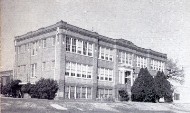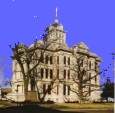Milam County Historical Commission
Milam County, Texas
Milam County, Texas






All credit for this article goes to
Marjorie Rogers, Marlin, TX
and
J. Marvin Hunter - Publisher of 'Frontier Times'
Marjorie Rogers, Marlin, TX
and
J. Marvin Hunter - Publisher of 'Frontier Times'
The Town of Calvert
By Marjorie Rogers, Marlin, TX
Frontier Times
Published by J. Marvin Hunter
October, 1931
Many years ago this little town enjoyed the reputation of having the largest cotton gin
in the world. Its main street was lined with saloons, cowboys, cotton wagons, and
stacks of gold was a common sight on the tables of the famous gambling house. This
peaceful village was the greatest trading point in this section of the country even
though it was almost depopulated by yellow fever which took its toll in Texas 63 years
ago.
Back in the days when the Brazos bottom was a free range, and the woods and prairies
were full of wild cattle; when school houses were considered somewhat of a novelty in
Texas, and the settlers were scattered sparingly over this hunter’s paradise; when the
chief business in Central Texas was that of driving beef-cattle from the interior of
Texas to New Orleans and other markets just a few years after Robertson County had been
sliced off the great Milam Land District, Judge Robert Calvert and his wife, Mary
Keesee, heard and read the wonderful stories of Texas and her opportunities and packed
their wagons, waved goodby to their friends in Saline County, Arkansas, and drove away
to Robertson county.
In Alabama and Arkansas Judge Calvert had engaged in agricultural pursuits, and was
considered a successful farmer. He owned thousands of acres of land in the vicinity
of the present town of Calvert. Although he moved to Robertson county in 1850, it was
not until the coming of Houston and Texas Central Railway through the county that the
town was established. With that same keen foresight that prompted him to move to the
Brazos bottom he advocated the extension of the Houston and Texas Central Railway
through his county, and, as contractor in connection with Judge William Davis and Major
William Hanna, he graded several miles of that road. This infant town was on one of
the oldest routes of travel in Texas. During the Colonial period there was a Mexican
garrison and a few stores at Tenoxtician just below the county line.
Before the coming of the “iron horse” the commodities were hauled by ox-wagons and
horse wagons to Houston, Nachitoches, Louisiana; a distance of 300 miles, and other
points. Old Sterling, Franklin, Wheelock, Eutaw and Owensville, were the leading
trading centers until Judge Calvert saw the advantage of a railroad through the county.
At this time the Stroud family owned the present site of Calvert but because of the
part that Judge Calvert took in getting the tracks through the Stroud site, the town
was named for him. It was a common sight to see six or eight wagons drawn by oxen
slowly passing through the one and only street of these towns enroute to Houston to
dispose of their cotton. These wagons averaged ten miles a day. The team-masters
usually owned their teams and were paid so much per hundred pounds for hauling freight.
It was between Hearne and Bryan that I saw my first railroad train, said W. S. Allen,
pioneer business man of Calvert. I had seen long wagon trains coming through Port
Sullivan enroute to Houston. These wagons were loaded with cotton and other
commodities for Houston market. All produce was sold in Houston because it was nearest
market, and the best. It sounded wonderful to think that a locomotive could cover a
distance of fifty miles and carry loads that a thousand ox-teams could not have taken
in two weeks. The inhabitants of our country had been compelled to drag their produce
over the level prairies with sixteen yoke of oxen. Many times the prairie and bottoms
were submerged in water. It was a slow, difficult, uncertain and expensive method of
carriage. Naturally we were all watching with interest the laying of new tracks. I
was riding my pony the day that I saw my first train. I heard this terrible puffing
and blowing noise and it frightened me and my horse. He squatted as if ready to make a
wild jump and run away. I put the quirt to him and got him away from the scene as fast
as I could. It was a construction train. The first trains that came through Calvert
burned wood in the engines and traveled about twenty miles an hour. One engine did not
pull over twenty cars. I can remember when passenger trains did not run on Sunday as
people in those days did not believe in desecrating the Sabbath by riding on the train.
The musty old records of Franklin show that an order of election for the incorporation
of Calvert was given for July 5, 1969. All qualified voters under the reconstruction
laws of Congress of the United States residing in the limits of said village as herein
described shall be permitted to vote at said election. Returns showed that majority
voted against incorporation. It was believed that a fair expression of the qualified
voters was not had. So it was ordered that the previous election be set aside as void,
that a new election be held on Saturday, July 24, 1869. Returns showed a majority for
incorporation, so Judge Ellison ordered the town incorporated, Aug. 13, 1869.
“The town was twice as large when I first came and went into business as it is now; the
store buildings were frame but as they were gradually destroyed by fire, brick
buildings took their places,” said Mr. Allen. “Our sanitary conditions were not so
good then. The hogs bedded under the stores and the cattle ran at will over the town.”
“For many years Calvert had the distinction of having the larges cotton gin in the
world,” said Scott Fields, Sr. “The gin was built by John H. Gibson in 1876. Later
his sons P. C. and J. H. Jr. took the business in charge, and enlarged it. It had
twenty-one stands and an oil mill in connection. Farmers brought cotton to Calvert
from all parts of the Brazos bottoms to be ginned and sold. There were 32,000 bales
received in 1882.”
The people of Robertson county had a time locating their county seat. After the
county was organized in 1838 the people chose Franklin. By the time a courthouse and
jail had been built an election was held to move it again and it was moved to Wheelock.
The courthouse build by A. L. Brigance was accepted sometime in August, 1853. Robert
Calvert was one of the five commissioners appointed by the Court November, 1854, to
procure from the District Surveyor a certificate showing the precise center of the
county and selected two or more places within five miles of the center of Robertson
county for another county seat. Owensville was selected and courthouse and jail built.
About the time these buildings were finished the county seat was again moved to Calvert
in 1870. Nine years later another election was held to move the county seat again and
Morgan was elected.
“The town of Calvert was almost depopulated by the scourge of Yellow Fever in 1873,”
said Judge Fields. “The disease was brought to town by a traveling printer from
Louisiana where the fever was raging. He took a room over the restaurant in the Bailey
building and died there. As many persons as could made an exodus before the town was
quarantined. We lost between three and found hundred persons. The fever was a
terrible epidemic, and out people suffered because we did not know how to treat the
disease. The trains were not allowed to stop in Calvert then and the windows of the
coaches were closed until they were far out of town”.
The first shoe shop in Calvert was established by E. Conitz of Posen, Germany, who
moved to Calvert in ’71. According to W. S. Allen, Mr. Conitz made fancy boots for
all of the cowboys. It was the fad for men to wear high heel boots that made their
feet look small. “In those days men were vain over their small feet. We paid Mr.
Conitz fifteen and twenty dollars a pair for French calf-tongue boots with quilted
Morocco leg tops. The tops were quilted in colored roses and other designs. When we
put those fancy boots on and went to church at Little River, we felt mighty dressed
up.”
One never talks to an old settler of either Robertson or Milam county without hearing
of “the trip of the Washington,” being the ascent up Little River of the first and only
steamer that ever plowed the waters of that stream. According to J. W. McCown, who had
the distinction of residing in the second brick house built north of the old San
Antonio road and west of the Trinity river, the trip was made in the winter of 1850-51,
and was the conception of his father, who was engaged in business in Cameron. “It
seems that he had mentioned several times to some of his acquaintances the possibility
of navigating Little River with small boats during the winter freshets, but his
suggestions had generally met with ridicule. At last, just after a particularly heavy
rain, when the river was considerably swollen and gave promise of remaining up several
days, he hastily constructed a skiff and put out for the lower Brazos country in search
of a steamer to make the attempt. He secured one at Washington called ‘The
Washington’, the property of Captain John Woods and commanded by Captain Hatfield. The
trip was undertaken on the payment of a bonus of $500 and guaranteed amount of freight
at stipulated rates. The boat was loaded with a cargo of merchandise, consisting of
groceries, provisions and whiskey, and the ascent begun. It did not excite much
interest along the Brazos, but when Little River was reached the sound of a steam
whistle, never heard before in these parts, instantly attracted attention, and when it
came to know that a real, live steamer, duly equipped and fully loaded with
merchandise, was in the river making its way to Cameron, curiosity quickened into
interest and interest grew into excitement, general and prolonged. My father, who was
enjoying something of a personal triumph in the success of the enterprise, spared no
pains to spread the news as to what was going on. Word passed rapidly from house to
house, and it began at a timer of the year when the people were idle, crowds soon began
to flock to the river banks from all directions. Men, women and children, all ages,
sexes, and conditions, in all stages of dress and undress – a motley company of
curiosity seekers came pouring out from the settlements.
“As the Washington puffed and wriggled along the winding stream, dodging a lot of
drift-wood here and clearing a sharp angle there, knots of sight-seers would greet it
with a great profusion of shouts and hurrahs, and much waving of wool hats and calico
bonnets and aprons. Passengers were taken at each stop, any one being at liberty to
ride, and when stops were not made some of the more ambitious swam out into the river
on horseback and climbed on the steamer while in motion. In this way the boat rapidly
filled up until it became a mass of surging, shouting, rollicking humanity. It stopped
when it reached the shoals, about two miles and a half of Cameron, was made fast to a
tree, and, in accordance with instructions, the decks were cleared and a general
jubilee of feasting and dancing set in. For two days and nights this went on until all
were surfeited with fun and frolic, when the Captain cleared away the debris, turned
the nozzle of the Washington down stream and glided back into the waters of the Brazos.
The event left a lasting impression on the settlers and its incidents afforded topics
for conversations for a long time afterward.
Like the passing of the cattle industry, and the Indians from the vicinity of Calvert,
the pioneer settlers, who once started at the shriek of the “iron horse” as it for the
first time penetrated the wilderness of Robertson county and rushed north to make
neighbors of heretofore unknown counties, are leaving their ranks and giving their
places to their children and grandchildren. Just a few more years and the strange and
wonderful stories of pioneer days will be heard no more from these true builders of
civilization. Men with vision of that like Judge Calvert saw the advantage of a
railroad. His town lived on while Owensville and Wheelock perished. He was past the
age for military service during the Civil War but he fitted the wagon trains and
supplied the soldiers with horses and other equipment. His only public service in
Texas was that of a Representative from Robertson county in 1853 and 1860. He died
September 20, 1867, but he left his name for a guiding torch for courage, vision and
progress.
.